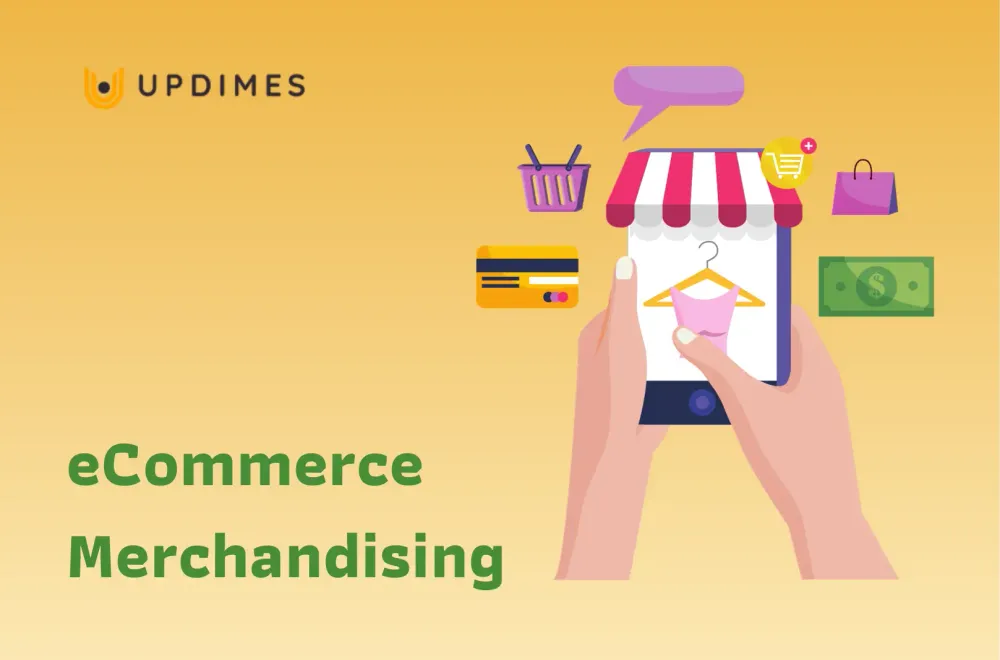ECommerce Merchandising: All You Need to Know

ECommerce merchandising is a vital component of online retail success. In this article, we will provide an in-depth exploration of what is eCommerce merchandising, and the best practices for small businesses to apply it.
Whether you're a seasoned eCommerce professional seeking to enhance your strategies or a newcomer eager to understand the fundamentals, this comprehensive guide equips you with the knowledge and tools necessary to excel in the digital marketplace. Uncover the secrets of online retail success and unlock your eCommerce potential with us.
What is eCommerce Merchandising?
ECommerce merchandising is the strategic practice of curating and presenting products within an online store to increase sales and improve the overall shopping experience. It involves a combination of data-driven decision-making, product placement, pricing, and visual elements like images and descriptions.
Successful eCommerce merchandising entails understanding consumer behavior, leveraging data analytics to make informed decisions, and employing persuasive tactics to guide shoppers toward purchasing. It also involves continuous adaptation and optimization to keep up with changing market trends and customer preferences.
In essence, smart merchandising creates an attractive, user-friendly, and effective online shopping environment to maximize revenue and customer satisfaction.
The Importance of Ecommerce Merchandising
ECommerce merchandising holds immense importance in the ever-expanding realm of online retail. It is not merely about showcasing products but involves a holistic strategy to optimize the shopping experience, increase sales, and maximize profitability.
Firstly, eCommerce merchandising directly impacts sales and revenue. Effective product placement, pricing strategies, and persuasive visual elements can significantly influence purchasing decisions. By tailoring the online shopping experience to meet customer preferences and needs, businesses can boost conversion rates and, ultimately, their bottom line.
Secondly, it fosters customer engagement and satisfaction. When consumers find products quickly and easily, receive relevant recommendations, and enjoy a seamless shopping journey, they are more likely to return and become loyal customers. A well-merchandised eCommerce site creates trust and fosters positive user experiences.
Thirdly, eCommerce merchandising is essential for staying competitive in the digital marketplace. With countless online stores vying for consumers' attention, those that excel in merchandising gain a competitive edge. Adapting to changing market trends and customer behaviors ensures businesses remain relevant and appealing.
What are The Fundamental Elements of eCommerce Merchandising?
ECommerce merchandising involves several fundamental elements that collectively contribute to creating a compelling online shopping experience. These elements help guide customers through the digital storefront, present products attractively, and ultimately drive sales. Here are the key components of eCommerce merchandising:
Homepage Merchandising
The homepage is often the first impression shoppers have of an online store. Effective homepage merchandising involves strategically featuring products, promotions, and content that align with the store's objectives and customer interests. Key elements of homepage merchandising include:
- Hero banners: Eye-catching, high-quality images or banners showcasing new arrivals, seasonal collections, or special offers.
- Featured products: Highlighting bestsellers, new releases, or items on sale to capture immediate attention.
- Content integration: Integrating relevant blog posts, videos, or other content to engage and educate customers.
- Navigation menus: Clear and intuitive menus that help users find their desired categories or products.
Product Pages
Effective product pages are crucial for converting browsers into buyers. They provide detailed information and visuals that help customers make informed decisions. Elements of product page merchandising include:
- High-quality images and videos: Multiple images and videos showcase the product from various angles and in use.
- Compelling product descriptions: Detailed and persuasive descriptions that answer common questions, highlight features, and provide sizing and care information.
- Pricing and discounts: Displaying the price, any discounts, and available payment options.
- Customer reviews and ratings: Providing social proof through honest customer feedback and ratings. You can collect and display product reviews better with Ryviu app.
- Call-to-action (CTA) buttons: Prominent CTA buttons like "Add to Cart" and "Buy Now."
Category-Based Merchandising
Categorizing products and optimizing category pages is essential for efficient navigation and product discovery. Key components of category-based merchandising include:
- Logical grouping: Organizing products into meaningful categories and subcategories.
- Filters and sorting options: Allowing customers to refine product listings by price, size, color, and other relevant attributes.
- Featured Categories: Showcasing specific categories or collections on the homepage or through navigation menus.
- Breadcrumb vavigation: Providing a clear path for users to navigate back to higher-level categories or the homepage.
Cross-Merchandising
Cross-merchandising involves suggesting related or complementary products to customers, increasing the average order value and the shopping experience. Key elements of cross-merchandising include:
- Related products: Displaying items that pair well with the product being viewed.
- Frequently bought together: Bundling products that are commonly purchased in combination. You can easily set up product bundle by using Shopify frequently bought together apps.
- Upsell and cross-sell recommendations: Encouraging customers to consider higher-end or additional products.
ECommerce Merchandising: 10+ Best Practices for SMBs
Here are 10+ best practices to help SMBs elevate their eCommerce game and create a memorable shopping experience for their customers.
#1. Steal your visitors' hearts with hot deals
One of the quickest ways to capture the attention of potential customers is by offering hot deals and promotions. Prominently feature special offers, discounts, and limited-time deals on your homepage. Ensure that these deals are visually appealing and clearly communicated. This can entice visitors to explore your offerings further and increase the likelihood of conversions.
#2. Utilize customer reviews
Customer reviews and ratings are invaluable assets for SMBs. Showcase genuine reviews on your product pages to build trust and credibility with potential buyers. In this case, you can use Ryviu app to collect product reviews quickly and display them better.
Positive feedback from previous customers can reassure new ones, helping them make informed decisions about their purchases. Responding to reviews, both positive and negative, can also demonstrate your commitment to customer satisfaction.
#3. Consider social commerce as the new e-Merchandising
Social commerce has become a powerful avenue for eCommerce success. Consider integrating your online store with social media platforms. This allows your products to be easily discovered and purchased directly through social networks, creating a seamless shopping experience for your customers. Social media can also serve as a valuable channel for promoting your products and engaging with your audience.
#4. Apply a grid-based layout for product pages
Organize your product listings with a clean and structured grid-based layout. This approach simplifies navigation and enhances the overall user experience. Each product should be presented consistently with a high-quality image, concise description, price, and a clear call-to-action (CTA) button, such as "Add to Cart." Grid-based layouts make it easy for customers to scan and compare products.
#5. Make sure product images are clearly visible
High-quality product images are the backbone of successful eCommerce merchandising. Ensure that your product images are well-lit, properly framed, and provide the option for customers to zoom in for a closer look. Additionally, consider offering multiple images that showcase the product from various angles, demonstrating its features and benefits.
#6. More than images, use videos
Incorporate product videos alongside images to provide a more immersive shopping experience. Videos can offer a 360-degree view of the product, demonstrate its usage, and engage customers on a deeper level. When done effectively, videos can help customers make informed purchase decisions and reduce return rate due to misaligned expectations.
#7. Don't forget the text
While images and videos are important, comprehensive product descriptions are equally crucial. Customers rely on product descriptions to understand key details, such as product specifications, materials used, sizing information, care instructions, and any unique selling points. Well-written, informative content not only informs potential buyers but also persuades them to make a purchase.
#8. Capture user's attention with CTAs
The strategic placement of Call-to-Action (CTA) buttons is essential for guiding users through the purchasing process. Ensure that CTAs are clear, easily accessible, and consistently positioned on product pages. Common CTAs include "Add to Cart," "Buy Now," and "Learn More." Effective CTAs serve as navigational cues, directing users toward the next step in their shopping journey.
#9. Offer personalized product recommendations
Leverage data analytics to provide personalized product recommendations to your customers. These recommendations should be based on their browsing history, purchase behavior, and preferences. Tailoring product suggestions can increase cross-selling and upselling opportunities, enhancing the shopping experience and driving sales.
#10. Group related products
Organize your products into categories or collections based on themes, occasions, styles, or product attributes. Grouping related products together simplifies the customer's shopping journey and encourages them to explore additional items. Cross-selling and upselling become more effective when customers can easily discover related products.
Incorporating these best practices into your eCommerce merchandising strategy can help SMBs create a more appealing and effective online shopping experience.
ECommerce Merchandising: FAQs
What does an eCommerce merchandiser do?
An eCommerce merchandiser optimizes product presentation, pricing, and content within online stores to enhance the shopping experience and drive sales, often using data analysis to make informed decisions.
How do I become an eCommerce merchandiser?
To become an eCommerce merchandiser, gain relevant education and hands-on eCommerce experience, develop skills, stay informed about industry trends, network, create a portfolio, and apply for positions in online retail.
What is the difference between eCommerce merchandising and retail merchandising?
ECommerce merchandising optimizes digital storefronts for online shoppers, utilizing digital tools and global reach. Retail merchandising concerns physical stores, in-person consumers, and localized inventory management, often involving physical displays and store layouts to influence customer behavior.
Conclusion
In the fast-paced world of eCommerce, successful online merchandising is the linchpin that transforms casual visitors into loyal customers. By embracing these best practices, businesses can craft a shopping experience that captivates and convinces online shoppers. ECommerce merchandising is not just an art; it's the science behind driving growth and prosperity in the digital realm.
